

10 Interesting Futuristic Materials. 1.
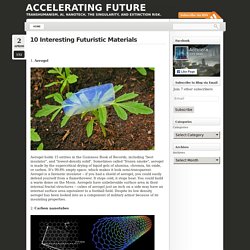
Aerogel Aerogel holds 15 entries in the Guinness Book of Records, including "best insulator", and "lowest-density solid". Sometimes called "frozen smoke", aerogel is made by the supercritical drying of liquid gels of alumina, chromia, tin oxide, or carbon. It's 99.8% empty space, which makes it look semi-transparent. These Tiny Capsules Suck Up CO2. We Can't Help Notice There's Something Nefarious About this New Crystal.
Chameleon for Optoelectronics. A liquid that changes its color “on demand” and can take on any color of the rainbow one desires?

A research team headed by Yadong Yin at the University of California, Riverside (USA) has now shared the secret of their wonderful liquid with the journal Angewandte Chemie: Nanoscopic particles made of tiny magnetic crystals coated with a plastic shell self-assemble in solution to form photonic crystals—semiconductors for light. When a magnetic field is applied, the optical properties of the crystals change, allowing their color to be very precisely adjusted through variation of the strength of the field. This Artificial Leaf Is An Oxygen Factory That Could Let Us Breathe In Space - CreativeNinjas. Humans have long dreamed of colonizing the moon and other planets, but unlike the Earth, these celestial bodies lack the trees and other plants that so kindly recycle our exhaled carbon dioxide into breathable oxygen.

Company develops new fiber-reinforced wood, concrete ink for 3D printing. Even though 3D printing is an emerging market and technology, aside from Defense Distributed’s gun, it seems like it has hit a plateau.

You can make little or somewhat-bigger-than-little figurines, teacups and mugs that often have leaks, or fragile parts — such as gears — that you can include in a working item, but might quickly wear down. One of the things holding 3D printing back is the material used to print objects. A San Francisco-based company, Emerging Objects, has created new printing materials that aren’t just plastic, but composed of wood, concrete, and even salt. For the uninitiated, normal 3D printing is additive. New bone-like material is lighter than water but as strong as steel. Materials shape human progress – think stone age or bronze age.
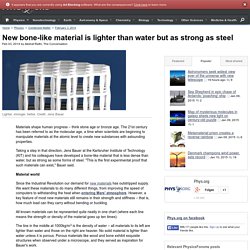
The 21st century has been referred to as the molecular age, a time when scientists are beginning to manipulate materials at the atomic level to create new substances with astounding properties. Taking a step in that direction, Jens Bauer at the Karlsruher Institute of Technology (KIT) and his colleagues have developed a bone-like material that is less dense than water, but as strong as some forms of steel. "This is the first experimental proof that such materials can exist," Bauer said. Material world Since the Industrial Revolution our demand for new materials has outstripped supply.
All known materials can be represented quite neatly in one chart (where each line means the strength or density of the material goes up ten times): Upsalite. Electron microscopy images of Upsalite — scale bar length: (A) 1 μm (B) 200 nm (C) 50 nm Upsalite is an anhydrous form of magnesium carbonate first reported in July 2013.[1][2] With a surface area of 800 m² per gram, Upsalite is reported to have the highest surface area measured for an alkali earth metal carbonate ever created.
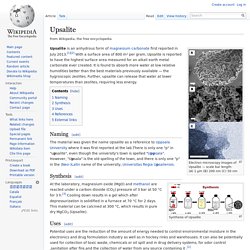
It is found to absorb more water at low relative humidities better than the best materials previously available — the hygroscopic zeolites. Further, upsalite can release that water at lower temperatures than zeolites, requiring less energy. Naming[edit] The material was given the name Upsalite as a reference to Uppsala University where it was first reported at the lab.There is only one "p" in "upsalite", even though the university's town is spelled "Uppsala". Synthesis[edit] Uses[edit] References[edit] External links[edit] Icists show unlimited heat conduction in graphene.
Scientists at the Max Planck Institute for Polymer Research (MPI-P) in Mainz and the National University of Singapore have attested that the thermal conductivity of graphene diverges with the size of the samples.
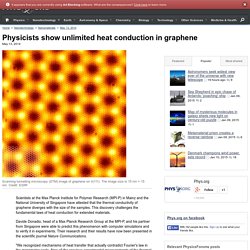
This discovery challenges the fundamental laws of heat conduction for extended materials. Davide Donadio, head of a Max Planck Research Group at the MPI-P, and his partner from Singapore were able to predict this phenomenon with computer simulations and to verify it in experiments. Their research and their results have now been presented in the scientific journal Nature Communications. Scientists just created some of the most powerful muscles in existence.
Upsalite. Robots Morph From Solid To Squishy. Well it looks like science has brought us another step towards a real-life Skynet and the destruction of mankind.
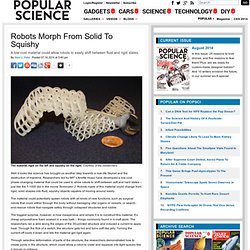
Researchers led by MIT’s Anette Hosoi have developed a low-cost phase-changing material that could be used to allow robots to shift between soft and hard states – just like the T-1000 did in the movie Terminator 2. Kinetic sand. Playing with super hydrophobia – Ultra-Ever Dry. Playing with super hydrophobia – Ultra-Ever Dry “Ultra-Ever Dry” is a super-hydrophobic coating (water repellent) and oleophobic (oil repellent) developed by Ultra-Tech company.

This coating from nanotechnology makes it possible to turn any surface impermeable to liquids and oils. If this explanation is not particularly exciting, the demonstration video worth the look! Pretty impressive, some super hydrophobia magic! White LEDs lighting directly on paper. Imagine a white luminous curtain waving in the breeze.
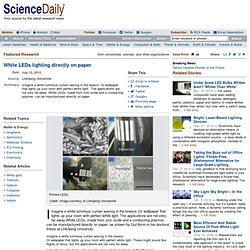
Or wallpaper that lights up your room with perfect white light. The applications are not very far away.White LEDs, made from zinc oxide and a conducting polymer, can be manufactured directly on paper, as shown by Gul Amin in his doctoral thesis at Linköping University. Imagine a white luminous curtain waving in the breeze. Or wallpaper that lights up your room with perfect white light. New approach assembles big structures from small interlocking pieces. MIT researchers have developed a lightweight structure whose tiny blocks can be snapped together much like the bricks of a child's construction toy. The new material, the researchers say, could revolutionize the assembly of airplanes, spacecraft, and even larger structures, such as dikes and levees.
The new approach to construction is described in a paper appearing this week in the journal Science, co-authored by postdoc Kenneth Cheung and Neil Gershenfeld, director of MIT's Center for Bits and Atoms. Professors' super waterproof surfaces cause water to bounce like a ball. Vanishing mirror turns into a window as you spin it - tech - 27 March 2014. Video: Vanishing mirror turns into a window You walk past a mirror, watching your reflection, when suddenly it disappears – the mirror has become a window. Such a mirror now exists thanks to a material that filters light beams based on the direction they are travelling in.
It could one day make it easier to photograph faint objects. Light is normally filtered based on its frequency or polarisation – think colourful stained glass windows, which only let through certain wavelengths of light, or polarised 3D glasses that ensure each eye sees a slightly different image by only letting through light waves that oscillate in a particular orientation. Non-Newtonian Fluids and Viscosity. Xion d30 Stunt Jacket Review. Liquid Armor. Smack Me On The Head With A Shovel! Superabsorbent polymer. Superabsorbent polymers (SAP) (also called slush powder) are polymers that can absorb and retain extremely large amounts of a liquid relative to their own mass.[1] Water absorbing polymers, which are classified as hydrogels when cross-linked,[2] absorb aqueous solutions through hydrogen bonding with water molecules.
A SAP's ability to absorb water is a factor of the ionic concentration of the aqueous solution. In deionized and distilled water, a SAP may absorb 500 times its weight (from 30–60 times its own volume) and can become up to 99.9% liquid, but when put into a 0.9% saline solution, the absorbency drops to maybe 50 times its weight. The presence of valence cations in the solution will impede the polymer's ability to bond with the water molecule.
The total absorbency and swelling capacity are controlled by the type and degree of cross-linkers used to make the gel. History[edit] Until the 1980s, water absorbing materials were cellulosic or fiber-based products. Uses[edit] K. 10 Amazing Man-Made Substances.